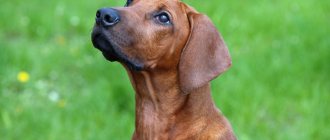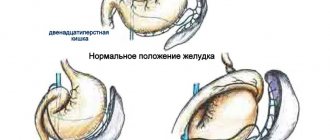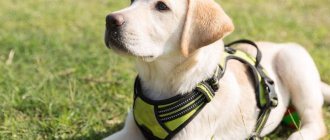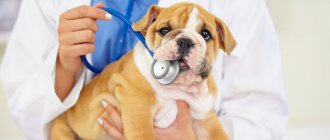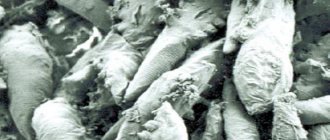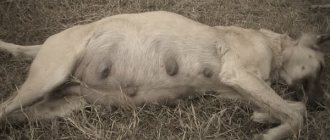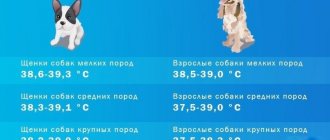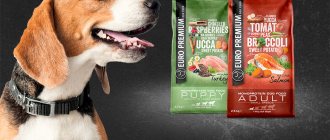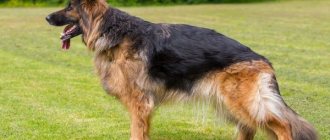Dog intestinal microflora
In a newborn puppy, the intestinal microflora is normally sterile; maternal colostrum gradually fills it with “good” bacteria. Growing up, the puppy tries new food, chews on toys, goes outside and bathes.
These factors contribute to the fact that new bacteria join friendly bacteria. The final formation of a set of different types of organisms occurs in 8-12 months. This microflora performs the following functions:
- strengthens the immune system;
- normalizes metabolism - the intestines absorb the necessary microelements and remove excess from the body;
- protects the animal’s body from harmful bacteria;
- carries out the synthesis of vitamins;
- absorbs, collects and removes toxins.
If the microflora ceases to cope with its responsibilities due to the activity of pathogenic organisms, the dog develops dysbacteriosis (dysbiosis). It is characterized by the loss of beneficial microbes - bifidobacteria, lactobacilli, E. coli and their replacement with fungi of the genus Candida, staphylococci and other pathogenic and conditionally pathogenic bacteria.
Dog intestinal microflora
The natural habitat of lacto- and bifidobacteria is the intestine. The colonization of the digestive organ by beneficial microorganisms occurs in the first 3-4 days after the puppy is born. A newborn animal receives beneficial bacteria primarily from the bitch’s colostrum.
Puppies after cesarean section are more susceptible to the development of dysbiosis, since they are deprived of access to colostrum in the first hours after birth.
In healthy puppies and adults, the intestinal microflora is predominantly inhabited by bifidobacteria, lactobacilli, and E. coli. These microorganisms perform a protective function. They inhibit the growth of microbes and neutralize the effects of toxins in the intestines.
Beneficial bacteria are involved in the process of absorption and breakdown of nutrients. In addition, probiotic and eubiotic microorganisms synthesize vital B vitamins in the dog’s intestines. They protect the animal’s body from viruses, helminth infections, and fungi.
External and internal negative factors gradually lead to beneficial microflora being replaced by pathogenic microorganisms:
- staphylococci; Pseudomonas aeruginosa; fungi of the genus Candida; Proteus.
To restore beneficial microflora, it is imperative to take probiotics, prebiotics or synbiotics, and prescribe a special diet as part of complex therapy.
Causes of dysbiosis in dogs
Dysbiosis in dogs, treatment of which should be started as early as possible, can be the result of various factors. The main ones include:
- violation of the feeding regime, the predominance of a large amount of carbohydrates in the diet;
- stress associated with moving to a new place of residence, adding another pet to the house, etc.;
- unfavorable environmental background;
- bad habit of picking up food on the street;
- habitat change;
- frequent and uncontrolled treatment with antibiotics, which kill not only the pathogenic environment, but also beneficial microflora;
- chronic gastrointestinal diseases;
- hypersensitivity of microflora;
- helminthic infestation.
Reasons for the development of dysbiosis
Dysbacteriosis can be a consequence of various changes in the dog's body. It can be called:
- improper feeding, large amounts of carbohydrate foods in the diet, vitamin deficiency,
- stressful situations (moving, separation from the owner),
- poor environmental situation,
- long-term use of antibiotics,
- gastrointestinal diseases,
- helminthic infestations,
- hypersensitivity of microflora.
More often, dysbiosis develops in puppies that switch to regular food instead of mother's milk, as well as in older dogs with a weakened immune system.
Signs of dysbiosis in a dog
Dysbacteriosis has a rather vague clinical picture, so it can easily be confused with other diseases - urolithiasis, intestinal circulatory disorders, liver damage.
You need to focus on the chronic course of the disease - the condition does not change even with a thorough correction of the diet and daily routine.
Signs of concern should include:
- bloating;
- flatulence;
- decreased appetite or lack thereof;
- apathy, depressed state;
- drowsiness;
- deterioration in the appearance of fur;
- bloody diarrhea or constipation;
- showing interest in food that the dog has never eaten before.
If you suspect dysbacteriosis, you need to monitor the dog for several days. An animal with a weakened immune system should be switched to a dairy diet, including goat milk, cottage cheese, curdled milk, and homemade yogurt.
In addition, the dog needs to be given immunostimulants, for example, Gamavit. If after a few days the condition improves, then we are really talking about dysbiosis.
The next step should be a visit to the veterinary hospital, where a specialist, taking into account the animal’s condition and signs, will explain how to treat the dog. To diagnose the disease, the following methods are used: biochemical blood test, stool examination, endoscopic examination.
Basic principles of treatment
Treatment for your dog will depend on the extent of the damage. At the initial stage, you can limit yourself to correcting your diet, taking nutritional supplements and fermented dairy products that will help restore the microflora.
If dysbiosis develops rapidly, then you will have to resort to other measures.
The principles of complex treatment are based on:
- Elimination of excess colonization of the intestines. For this purpose, antibacterial drugs, bacteriophages, acetic and lactic acid are prescribed to normalize the microflora.
- Removing toxins that have accumulated during the period of illness. Infusion solutions and sorbents successfully cope with this task.
- Restoration of microflora. This is the task of probiotics containing beneficial bacteria, as well as prebiotics and eubiotics.
- Improving digestion, restoring metabolism. To do this, the doctor prescribes a special therapeutic diet, vitamin and mineral supplements.
- Increasing the body’s ability to respond to various physiological and pathogenic environmental stimuli. The body's reactivity is facilitated by the use of immunomodulators and immunocorrectors.
The main emphasis in the treatment of dysbiosis in dogs, especially its severe form, is on taking antibiotics. Ampicillin and Amptox sodium have proven themselves well. The veterinarian also prescribes Furadonin, Levomycetin, and saline solutions are administered subcutaneously and intravenously.
Treatment of dysbiosis in dogs also involves medications in the form of gastric enzymes, which are necessary for digestion.
The role of bacterial preparations that contain full-fledged viable flora is very important: bifidobacteria, lactobacilli, yeast. It has the ability to suppress pathogenic bacteria. Medicines containing substances that are a beneficial environment for normalizing microflora are called probiotics. Such drugs are Lactoferon, Bifitrilak, Fitobacterin.
Prebiotics are substances of non-microbial origin that provide a nutrient medium for the development and growth of normal intestinal microflora.
Complex preparations containing probiotics and prebiotics are called synbiotics.
Very often, the use of the probiotic “Emprobio” is prescribed for the treatment and prevention of dysbiosis. This drug improves the digestion process, displaces the pathogenic environment in the puppy and “populates” the body with the right bacteria, strengthens the immune system.
During treatment, the dog should drink the required amount of fluid. Stress and nervous shock are contraindicated for animals. You need to understand that the treatment will be long-term (1.5-2 months), so the owner will need considerable endurance and patience.
Side effects
There are no contraindications for probiotics, but an overdose or therapeutic dose of the drug sometimes causes side effects in dogs.
The most common reactions include constipation, diarrhea, and bloating. In this case, it is necessary to reduce the dose to a minimum, and then gradually increase it, monitoring the pet’s health.
Many dietary supplements contain other beneficial substances in addition to probiotics. The preparations are enriched with yeast, lactose, and prebiotic fibers. Some dogs have an allergic reaction to such components. If itching, redness, or hair loss occurs, you must stop taking it and change the medication.
Diet for dogs: how not to harm
On the first day of treatment, the dog is prescribed a fasting regime. The only food allowed is chicken broth. On days 3-4, the menu is replenished with raw eggs, on days 4-5 - with fermented milk products (milk, kefir). However, before this you need to find out if the dog has allergies.
The further diet is prepared by the doctor depending on the condition and conditions of detention. The main task of therapeutic nutrition is to normalize intestinal activity and reduce the activity of putrefactive processes.
The diet must be carefully balanced in terms of energy and nutrient composition. The content of proteins, fats, and carbohydrates must be in strict accordance.
The dog menu should include dishes enriched with vitamins and minerals, dietary fiber, and live bacterial cultures.
Fatty foods and dry food must be excluded.
It is easier to prevent any disease than to treat it. Dysbacteriosis can be completely avoided if you follow certain preventive measures. In some cases, such as stress, long-term debilitating illness, or antibiotic therapy, it is better to start giving your dog probiotics right away. It is impossible for them to cause harm to health, but it is quite possible to prevent the process of microflora disruption.
During life, the animal’s body is exposed to the harmful effects of a variety of external factors. One of the key places for such negative impacts should be allocated to pathogenic and conditionally pathogenic bacteria, viruses, fungi and various toxins. Of course, the main victims are animals that regularly walk outside, although pets at home, due to decreased immune reactivity, can also experience environmental influences. But still, it is pets walking outside that are more likely to come into contact with pathogens. Pathogens are diverse. For example, nothing prevents a dog from drinking water from a puddle, picking up something, and sometimes simply “rolling around” in the mud. The “bouquet” of microorganisms that get onto the surface of the skin and into the digestive tract is very diverse. However, for the animal this, in most cases, ends well.
The gastrointestinal tract, skin, mucous membranes of the respiratory tract and eyes have means of protection provided by the immune support of the dog’s entire body. This is the very first and most important line, which aims to prevent penetration from the outside. A whole army of cells, which is located on the entire surface of the mucous membranes and skin, is involved in the confrontation. barrier (local) immunity draws its strength from the depths of the body - from general immunity, and the stronger it is, the stronger the local bacteriostatic properties.
Dog intestinal microflora
The longest contact with pathogenic and dangerous microorganisms occurs in the dog's intestines . His arsenal of defense mechanisms is varied. Intestinal mucus contains lysozyme, bile acids and digestive enzymes; the intestinal epithelium is supplied with macrophages and Peyer's patches; The main submucosal wall of the dog's intestine is penetrated by a network of lymphatic vessels with many lymphocytes. Each of these departments perfectly performs its functions to protect the body and forms the strength of the dog's immunity . A separate category of protective agents is provided by probiotic or eubiotic microorganisms that constantly live in the dog’s intestines. This is the so-called normal intestinal flora. The number of these microorganisms is enormous. It differs in its characteristics in each section of the intestine, but, in general, is calculated in thousands and hundreds of billions in each gram of intestinal contents. The large intestine is the most densely populated place with microorganisms.
Formation of normal microflora in the puppy’s intestines
Immediately after birth, the dog’s intestines are populated by microorganisms, the composition of which is quite individual for each individual individual. These eubiotic bacteria enter the body mainly from the mother, during the passage of the newborn through the birth canal, and later in the process of receiving colostrum, partly from the immediate environment. In the first 3-4 days of life, normal flora is formed and spreads throughout almost the entire intestine of the dog. The composition of colostrum and milk in the first hours and days of an animal’s life directly determines the quality and stability of probiotic bacteria. This is achieved through the entry of immune complexes through the semi-permeable intestines of the puppy directly into the lymphatic and circulatory systems of the body. Therefore, natural feeding is key and fundamentally important for any newborn. Bifidogenic factors of colostrum promote the development of microorganisms specific to a given animal species and guarantee their distribution within the required territory in sufficient quantities.
Individuals born by cesarean section or who have not received colostrum run the risk of acquiring environmental microflora that will not be beneficial to them. Moreover, it can harm them. Deprived of the natural support of probiotic microorganisms, they become very vulnerable in many ways. Such animals require a comprehensive and thoughtful administration of specific probiotic preparations that stimulate the development of normal dog intestinal microflora .
When transitioning to independent adult nutrition, more and more new microflora enters the dog’s body with food. During this period, animals that are not ready to adequately perceive it experience serious disruptions in the functioning of the gastrointestinal tract and digestive disorders, which often take a lot of work to normalize. Only the use of probiotics containing bifidobacteria as therapy can somehow solve the developing problem.
Environmental factors that negatively affect the animal’s body gradually lead to disruption of microbial balance. This phenomenon is called dysbiosis or intestinal dysbiosis. With dysbacteriosis in dogs, beneficial microflora organisms begin to disappear from the intestines, and pathogenic and opportunistic types of microorganisms begin to predominate. Bifidobacteria, lactobacilli, and E. coli begin to replace staphylococci, Proteus, fungi of the genus Candida, and Pseudomonas aeruginosa. Dysbacteriosis in dogs aggravates the course of many concomitant diseases, significantly complicating them. The load on the digestive organs increases, the absorption process is disrupted and, as a result, chronic diseases of the skin and respiratory tract are complicated. Therefore, treatment of dysbiosis in dogs must be mandatory and specific; it may require the administration of probiotics, prebiotics, and sometimes synbiotics. How to classify these drugs, which at first glance seem to be common in their action?
Gastroenterological drugs
Probiotics are live beneficial bacteria. Normally, many microorganisms are found in the intestines of any animal, and probiotics make it possible to replenish their number and, accordingly, suppress harmful microflora. Intestinal microflora is a very important component for the proper functioning of the gastrointestinal tract.
It performs many different functions that the animal’s body is not always capable of. Prebiotics are food components that are not digested or absorbed in the animal’s stomach and intestines, but are food for microorganisms that populate the intestines.
And most importantly, these components feed only beneficial microflora, preventing them from feeding on harmful ones. As we have already found out, intestinal microflora is very important for the proper functioning of the gastrointestinal tract.
Improper feeding, sudden changes in diet, treatment, especially with antibiotics, eating dirty snow or drinking water from puddles, as well as stress, travel, decreased immunity - all this undermines the healthy flora, reduces its quantity - dysbacteriosis occurs. Pre- and probiotics are used not only for treatment, but also for the prevention of dysbiosis. If you decide to change your pet’s food, or are going on a trip, or when your dog drank water in a nearby pond while out for a walk, it is better to play it safe and give her a course of pre- or probiotics.
When switching to a new food. Regardless of how similar two different foods are, they are produced from different raw materials, using different methods and often even in different factories. Therefore, your pet’s gastrointestinal tract may react negatively when switching to a new food. If you start giving pre- and probiotics shortly before switching to a new food, and continue to give them until your pet starts eating only the new food, you can prevent stool failure and also make the food more attractive to your pet.
Any treatment, especially antibiotics, affects the microflora of the gastrointestinal tract. Unfortunately, this cannot be completely avoided. But you can help the intestinal microflora if after treatment you give your pet a course of pre- and probiotics. Then the microflora will be restored faster, and stool loss can be avoided.
During walks in winter, many dogs eat snow, and in summer and in the off-season they drink from puddles and ponds. Water from these sources is usually contaminated with harmful substances, and stagnant water contains a lot of different microorganisms that have an adverse effect on the dog’s intestines. Drinking water from such sources may lead to vomiting and diarrhea. A preventative course of pre- and probiotics will help strengthen the intestinal microflora in advance and reduce the impact of harmful substances on your pet’s body.
Stress, for example, during fireworks displays or trips to the veterinary clinic, or moving, has an adverse effect on the animal’s body. Of course, the intestines also suffer, along with the bacteria that live in it. A decrease in immunity due to illness, during the vaccination period, and in the off-season also affects the beneficial intestinal microflora. You can support the microflora and increase its quantitative and qualitative composition in advance with a course of pre- and probiotics. Currently, there is no need to experiment with drugs for humans; pre- and probiotics specifically for dogs and cats can be found in stores.
Let's look at several drugs and find out for which situation each of them is better suited. This is a probiotic preparation in the form of a dry powder that contains live Enterococcus faecium microorganisms. The probiotic is contained in the form of microcapsules, which eliminates the digestion of bacteria in the stomach. The protective film dissolves only when exposed to gastric juice, allowing bacteria to freely penetrate the intestines.
The supplement is sold in sachets, 30 sachets per box. There is FortiFlora for dogs and for cats, they differ in the content of additives. The preparation for cats additionally contains taurine, which is not produced in the body of cats, and the preparation for dogs is rich in vitamin C.
The entire contents of the bag must be poured into your pet’s food once a day. The FortiFlora supplement contains meat and its processed products, so the supplement has an attractive smell, so it is eaten with pleasure by both dogs and cats. It is convenient to pour the powder onto the food, but, unfortunately, it may partially fall to the bottom of the bowl and not all of it will be eaten. This drug is also a probiotic for Enterococcus faecium, but is available in the form of a paste, which is very convenient to squeeze out of a dispensing syringe.
The paste can be squeezed onto food or directly into the animal’s mouth. And picky cats can get their paws dirty in it - the cat will start washing itself and lick off all the probiotic! Pro-Kolin contains beef flavoring, which increases its appeal to our pets.
But the probiotic does not contain beef protein, therefore, there can be no allergy to it. Available in volumes of 15 ml, 30 ml and 60 ml, which allows you to buy as much of the drug as you need for the course specifically for your pet.
Pro-Kolin probiotic also contains pectin and kaolin. Kaolin is a white clay composed of the mineral kaolinite. Kaolin is a natural adsorbent of harmful substances, and it also has bactericidal properties. During diarrhea, kaolin absorbs harmful substances, forms feces and helps reduce or completely eliminate diarrhea.
Pectin is a polysaccharide that can inhibit the growth of harmful intestinal microflora. Pectin, like kaolin, has an adsorbing effect. Both of these substances help to quickly stop or reduce diarrhea, making it easier for beneficial bacteria to colonize the intestines.
Despite its many beneficial properties, Pro-Kolin is not a medicine. If your pet has vomiting or very intense diarrhea that does not stop for more than hours, you should not experiment with treatment, you should immediately consult a veterinarian. This is a prebiotic drink that does not contain live microorganisms. This prebiotic contains fructooligosaccharide fibers and inulin.
They are not digested in the gastrointestinal tract of animals, but reach the large intestine, where they are fermented and serve as food for beneficial microflora, while suppressing harmful ones. The prebiotic is sold in sachets, 7 sachets per package. Viyo is designed for dogs and cats of different ages, so it is not difficult to choose a supplement specifically for your pet. The prebiotic can be used in its pure form, mixed with food or water. Such a high coefficient is achieved due to a special combination of meat, animal by-products, plant products, oils, fats, milk and dairy products.
Because this drink is so tasty, it is often given to cats that don't drink much. By adding a prebiotic to water, you can make it more attractive to your cat, and she will drink with greater pleasure. It is also very convenient to switch your pet to a new food using Viyo. A tasty drink will make the new food more attractive to your pet, and the prebiotic it contains will support the intestinal microflora while the body gets used to the new diet.
Visible results from taking the drug occur after about two weeks of daily use. It is recommended to give the drink to animals for 4 weeks, repeating the course 4 times a year. Viyo Reinforces Cat Adult prebiotic drink for adult cats.
Viyo Reinforces Cat Senior prebiotic drink for older cats. Viyo Reinforces Dog Puppy prebiotic drink for puppies. Viyo Reinforces Dog Adult prebiotic drink for adult dogs. This drug is different from all those listed above, as it contains both the prebiotic gum arabic and the probiotic Enterococcus faecium.
It comes in capsule form, but if you find it difficult to persuade your pet to eat the capsule, you can open it and pour the contents onto the food. Live bacteria and food for them in one capsule - what could be more convenient! Indeed, most preparations contain either a prebiotic or a probiotic.
But in many situations both are necessary. Then it will be much more convenient and cheaper to choose a synbiotic, rather than mixing several different additives. Pre- and probiotics are very important supplements that support the intestinal microflora at the level necessary for good functioning of the gastrointestinal tract.
Many factors in our pets' lives negatively impact beneficial gut bacteria. Stress, a change in diet, poor-quality food and feed, decreased immunity and much more can affect the microflora, reducing its quantitative and qualitative composition.
Most often, this does not lead to visible consequences for us, such as diarrhea. But this does not necessarily mean that the microflora is not affected. It’s just that the animal’s intestines and immune system cope and compensate for the lack of microflora.
In order to restore the number of beneficial intestinal bacteria, pre- and probiotics are used. Beneficial microflora not only participates in the functioning of the gastrointestinal tract, but also destroys harmful bacteria, preventing the animal from getting sick. Pre- and probiotics are not drugs, they have no side effects and cannot be overdosed. The worst thing that will happen if you give your pet a lot of supplements at once is that most of them simply will not be able to take hold and will be released in the feces, but the required amount will still remain in the intestines.
Prevention is the best cure. If your pet is expecting any changes soon, if he ate or drank something inappropriate, you can give him a course of pre- and probiotics to prevent dysbiosis. Or you can give these supplements in courses recommended in the instructions to always maintain your pet’s intestinal microflora at the proper level. In the online pet store Mister Woof you can buy prebiotics and probiotics for dogs and cats with delivery throughout Russia, Kazakhstan and Belarus.
We will quickly send supplements to any city, and for Chelyabinsk and Kopeysk we will deliver them to your door by our own courier service. Register Login. For dogs Delicious promotion! Home — Articles — Prebiotics and probiotics for dogs and cats. Prebiotics and probiotics for dogs and cats. Share with your friends:. First you need to understand what prebiotics and probiotics are, and how they differ? Did you like the article? Tell your friends: Comments There are no comments yet.
Probiotic Emprobio
The recently developed probiotic Emprobio . It contains a mixture of cultures of Lactobacillus casei, Lactococcus lactis, Lactobacillus plantarum, Lactobacillus ac /> The number of living microbial cells in 1 cm 3 of probiotic is at least 106-108. And although there is nothing fundamentally new in its composition, nevertheless, the concentration and proportions of microorganisms in it are the most successful and optimal. Due to its composition, this complex probiotic allows you to replace several drugs at the same time. It is used for the prevention and treatment of gastrointestinal diseases of all types of domestic animals and poultry. It improves digestion and further absorption of nutrients, creates favorable conditions for digestion by restoring the dog's intestinal microflora ; has a hepatoprotective, adsorbent and immunostimulating effect on the body as a whole.
Doses of the drug are prescribed individually, but an approximate prophylactic dose can be considered:
- cat or dog (weighing 3-6 kg) - 2.0 ml orally 2 times a day - up to 14 days;
- dog (weighing 7-10 kg) – 3.0-4.0 ml orally 2 times a day – up to 14 days;
- dog (weighing 15-20 kg) – 4.0-4.5 ml orally 2 times a day – up to 14 days;
- dog (weighing 25-45 kg) – 5.0-5.5 ml orally 2 times a day – up to 14 days;
- dog (weighing 55-80 kg) - 6.0-7.0 ml orally 2 times a day - up to 14 days.
In acute processes, the dosage of the drug can be increased by 0.5-1.0 ml, and the total duration of the course - up to 3-4 weeks.
From all that has been said above, we can conclude: probiotics are no less important for the animal’s body than vitamins, mineral supplements and timely vaccination. In some cases, they are a valid alternative to certain medications and, especially, antibiotics. Thoughtful administration of probiotics for both preventive and therapeutic purposes can prevent many diseases of the dog’s gastrointestinal tract (indeed, any system of the body) and prolong the animal’s life for many years.

